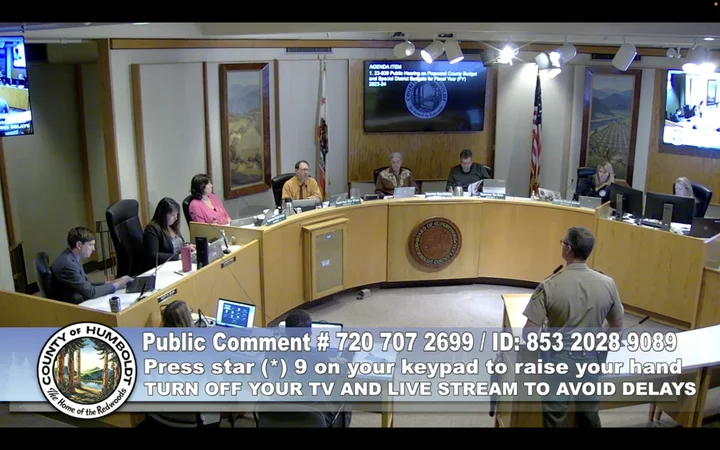The Humboldt County Board of Supervisors at Monday’s budget hearing as Sheriff Billy Honsal speaks at the lectern. | Screenshot.
###
The Humboldt County Board of Supervisors on Monday deliberated over some tough spending decisions as they considered the budget for the upcoming fiscal year and a dwindling pot of discretionary money to disperse from Measure Z, the county’s half-percent sales tax intended to maintain and enhance public safety and essential services.
Facing a $17.7 million deficit for the 2023-24 fiscal year, the board was presented with a number of potential cost-saving measures.
One option, previously used in 2011 during another budgetary shortfall, would be to launch an incentive program offering severance payments to employees who voluntarily resign. This Voluntary Separation Incentive Program (VSIP) would offer a $20,000 payment to eligible employees who have been with the county for 10 years or longer and who retire within the first month of the program. All other employees would receive $15,000 if they resign in that first month, with declining amounts offered over the following six months — first come, first served.
When this approach was employed a dozen years ago, 24 employees took advantage of the program. The county paid $233,000 in incentives but wound up saving roughly $5 million in salary costs and $3 million in General Fund expenditures over the next three years, according to a staff report.
Another option would be for the county to eliminate positions that have been vacant and/or unfunded for at least two years.
A third option, which is being researched by staff but not yet recommended or presented for implementation, would involve mandatory employee furloughs of various lengths — one or two days per month or a full week off between the Christmas and New Year’s holidays. Cost savings from this approach would range from $900,000 (for the unpaid holiday week) up to $5.4 million if employees were made to take two furlough days per month.
Back on May 22, seeing the dark fiscal clouds on the horizon, the board implemented an immediate hiring freeze through the end of the 2023-24 fiscal year.
Screenshot from a presentation at Monday’s budget hearing.
The total spending plan for the upcoming fiscal year is $578.55 million, which represents an increase of $7.2 million from the current fiscal year’s budget. The board is scheduled to adopt the new budget at a hearing on June 27, and the current draft would require the county to dip its General Fund balance to cover the $17.7 million shortfall.
The county also spent time considering how to allocate $397,000 in as-yet-un-obligated funds from the federal American Rescue Plan Act (ARPA) and $880,000 in anticipated Transient Occupancy Tax revenues from Measure J, a hotel tax approved last year.
Early in the hearing, Second District Supervisor Michelle Bushnell lamented the lack of sacrifice from county departments and funding recipients during this difficult time.
“[W]e have to make tough decisions and everybody wants a piece of the [pie] and nobody seems to be willing to give,” she said. “And I don’t know where we’re gonna get the money — and especially when everybody says, ‘No, not me. Pass the buck.’ The buck’s gonna really fall short.”
With much of Measure Z revenues already spoken for via ongoing grants and employee costs, the board had only $1.12 million in discretionary funding available to allocate for the 2023-24 fiscal year. That figure jumped up to $1.2 million after the board voted to defund a vacant IT position in the District Attorney’s Office.
After much deliberation — including some grilling of applicants by supervisors who wanted to know how little they could receive and still meet their goals — the board voted unanimously to award $320,000 to K’ima:w Medical Center’s ambulance program, $120,000 to Southern Trinity Area Rescue (STAR) ambulance services (whose territory extends into Humboldt County) and $195,438 to the Humboldt County Drug Task Force, with a small the remainder — roughly $562,000 — going to the Humboldt County Fire Chiefs’ Association.
But the board also noted the need to rethink how Measure Z funds are allocated in the future.
Glenn Ziemer, member and former chair of the Humboldt County Citizens’ Advisory Committee on Measure Z Expenditures, emphasized the need for this. [Note: A previous version of this story incorrectly identified Ziemer as the current chair. The current chair is Ginger Campbell. The Outpost regrets the error.]
“I truly believe with all my heart that unless you take some decisive, definitive action this year, you will lose any ability to normalize Measure Z and bring it back to the community service that it has been over the last nine years … ,” he said. “The simple fact of the matter is the normal inflationary costs of your payroll schedule … will totally overrun the fund and it will cease being the community-based benefit process it has been historically and simply turn into another line in the county’s personnel ledger.”
Humboldt County Sheriff William Honsal defended his department’s large, ongoing claims on Measure Z revenues, saying that if those funds went away, his department would have to eliminate 35 deputy positions and pull back on specialized services, focusing only on “that basic level of service throughout the county of a 911 response.”
Honsal and Third District Supervisor Mike Wilson had a long discussion about whether and how the Sheriff’s Office might make do with less, if necessary. County staff and the board’s Measure Z ad hoc committee — comprised of Bushnell and Wilson — will continue deliberations on Measure Z spending in the coming weeks.
As for the budget, the board directed staff to use the $397,000 in ARPA funds to offset the “urgent additional funding request burden” on the General Fund next year. They also approved the staff’s recommended parameters for a voluntary separation program and directed staff to continue researching a mandatory furlough option.
Again, the budget is scheduled to be adopted at a hearing on June 27.


CLICK TO MANAGE